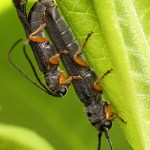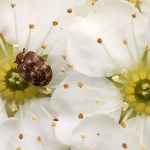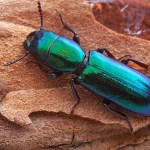Beetles
Leptinotarsa decemlineata
Urbana, Illinois
Meet the Colorado Potato Beetle.
If I had to make a list of ten insects all people should know, I'd probably put this one on it. Leptinotarsa decemlineata is a walking case study in evolutionary ecology.
Anyone with a potato patch will recognize this large, pin-striped beetle as a particularly voracious consumer of potato leaves. And that's true- the insect is a major agricultural pest. But it has only been eating potato plants for 150 years or so. Before that, L. decemlineata was an obscure insect found in the mountains of western North America…
[The following is a guest post by Rob Mitchell]
Rob here, back again with your answer to this week's mystery... not that you need it! And here I thought I was being tricky. Six points to FormicidaeFantasy for hitting the order, family, and genus, and another four to Gordon Snelling for making quick work of the specific epithet.
This beetle is a female Neoclytus tenuiscriptus, an uncommon little denizen of the American southwest (or the Mexican northwest, depending on where you're standing). According to Hovore's '83 monograph, the larvae bore in Baccharis, and specifically, can be found…
Glischrochilus sanguinolentus
Bell Smith Springs, Illinois
Just for you guys, here are some portraits of a colorful sap beetle in the family Nitidulidae I encountered in southern Illinois last weekend. It's a charming little insect, especially the cute, clubby antennae.
The challenge with shooting shiny insects such as Glischrochilus is lighting the insect without glare. The back of this animal is like a mirror, and if I were to just use the available sunlight or a bare camera flash all I'd get is a blown-out spot reflection of the light source with the rest of the animal appearing dark and…
What was the strange insect that seemed a mutant cross between a bee and a beetle?
Rhipiphorus wedge-shaped beetle, ovipositing into an aster Shawnee National Forest, Illinois
Kudos and all 10 points go to coleopterist extraordinaire Ted MacRae of Beetles in the Bush, who provided the correct answer Coleoptera: Rhipiphoridae: Rhipiphorus .
Rhipiphorus is unusual for a beetle. Coleoptera counts few parasites among its hundreds of thousands of described species. But the wedge-shaped beetles are ectoparasites of bees. Adults can be found on flowers, laying eggs that hatch into little bee-…
Oberea flavipes, phlox stem borer beetlesIllinois
Here's a boring beetle.
That is, the larvae bore. They make their living carving tunnels through stems and consuming plant tissue. This pair was hanging out in the phlox in our back yard, apparently plotting the demise of our summer flower garden.
photo details:
Canon EOS 7D camera
Canon MP-E 65mm 1-5x macro lens
ISO 100, f/13, 1/250sec
diffused twin flash
Thanks to Rob Mitchell for the ID.
Biologist Henry Hespenheide sends along this shot of several ant-mimicking beetles and their Cephalotes model:
What I take from this image is just how important the appearance of a narrow waist must be to successfully pulling off the illusion. These mimics differ considerably in body proportions, but they have all managed to paint a fake waist on their elytra.
Anthrenus sp. carpet beetle
Urbana, Illinois
Little Anthrenus beetles are one of the most common insects across the northern hemisphere. Adults can be found in flowers feasting on pollen, and the detritivorous larvae are often inhabitants of homes and buildings. If you'd like to see one of these yourself, check your window sills- there's a good chance a few will have accumulated around the edges as they try to exit.
A few years ago I attended an organizational meeting for the great Beetle Tree of Life project. A couple dozen of the world's greatest Coleopterists were crammed into a room…
Podabrus sp. Soldier Beetle
Urbana, Illinois
Last week we featured a larval soldier beetle. Today we have an adult of the same family (Cantharidae), in the genus Podabrus.
photo details:
Canon EOS 50D camera
Canon MP-E 65mm 1-5x macro lens
ISO 100, f/13, 1/250sec
This velvety worm-like creature may not look like a beetle, but it is. Beetles are like butterflies, passing through a complex metamorphosis on the way to adulthood, and this insect is the larval stage of a soldier beetle.
photo details:
Canon EOS 50D camera
Canon MP-E 65mm 1-5x macro lens
ISO 100, f/13, 1/250sec
Philothermus glabriculus (Cerylonidae)
Urbana, Illinois
A while back I noted that, at a rate of one beetle per week, I'd need about 10,000 years to get through all the described species. Since I made that comment we're getting closer to needing only 9,999 years, but if the Coleopterists keep discovering new ones I'm not sure what I'll do*. There are an awful lot of beetles.
In any case, this little Cerylonid is common under the bark of dead trees across eastern North America. Its diminutive size (only a couple millimeters long) makes it rather difficult to spot, so to find Philothermus you'…
...for no reason other than that I need something sparkly this morning.
Temnoscheila sp. bark-gnawing beetle, Trogossitidae
Tucson, Arizona
The reflective integument makes this beetle a real trick to shoot. It's like trying to photograph a mirror- a regular flash either reflects back at full, blown-out glare or not at all. So I shot this beetle in a white box, where the soft, even lighting can bathe the insect without sharp hightlights or deep shadows.
photo details:
Canon EOS 20D camera
Canon MP-E 65mm 1-5x macro lens
ISO 100, f/14, 1/250sec
Penthe pimelia (Tetratomidae)
Illinois, USA
A couple years back I was working on the Beetle Tree of Life project as a molecular phylogeneticist. My main responsibility was to gather DNA sequence data for several hundred beetles distributed across the spectrum of Coleopteran diversity.
As I'm not a Coleopterist, I spent most of my time lost in a befuddled daze of incomprehensible taxonomy. There are so many beetles. The larger families each hold more species than all of the vertebrates combined. Think about all the mammals and birds you know- the warblers, the polar bears, the shrews, the…
Dendroides fire-colored beetle,
Illlinois
We in the Friday Beetle Department don't often turn our attention to immature beetles. But these Dendroides larvae are too striking to pass up.
Dendroides fire-colored beetles inhabit the flat, two-dimensional space under the bark of dead trees. The oddly compressed body helps this insect squeeze through tight spaces looking for food.
update: Identification updated, on closer examination of the urogomphi. I think everyone should spend more time examining urogomphi.
Photo details: Canon mp-e 65mm 1-5x macro lens on a Canon EOS 50D
ISO 100,…
Hippodamia sp. Ladybird beetle
Tucson, Arizona
Photo details: Canon 100mm f2.8 macro lens on a Canon EOS 20D
ISO 100, f4.5, 1/320 sec, ambient light
Tenebrio molitor, pupa
Tenebrio molitor is a darkling beetle known more for its immature stages than for its adults. It is the ubiquitous mealworm. You can buy these granivorous beetles at any pet store as food for fish, birds, and reptiles.
The above shot of a developing pupa requires two sources of light. A flash head positioned behind the insect backlights the subject to produce the translucent glow. A second, positioned above and in front, is powered down and provides the highlights and details of the head and appendages.
Tenebrio molitor larva and pupa
Stronger backlighting gives…
This week was warm enough to go insect hunting in the yard, so the Friday beetle is back with new material. I snapped a few shots of this little staphylinid under a brick, figuring I'd identify it later.
That turned out to be a more complicated process than I'd anticipated.
It's a member of the the subfamily Aleocharinae, the obscure rove beetles. To arrive at an identification any more specific than that is basically impossible. The late James Ashe wrote:
The seemingly endless diversity, the small size of most adults, and the virtual lack of illustrated keys and descriptions of…
Harmonia axyridis, the Asian Multicolored Lady Beetle
If I had to pick the most annoying insect in Illinois it'd be Harmonia axyridis. This lady beetle was introduced to our continent as a control agent for aphids but became a pest in its own right. It consumes not just aphids but all manner of other insects, including beneficials like native lady beetles. Swarms of them descend into our houses in the fall. They get just about everywhere. They have a noxious odor. And they bite.
A study out in PLoS One byLombaert et al has determined that our local beetles here in eastern North America are…
Ostoma pippingskoeldi, Sierra Nevada, California
If you peel back the bark of an old stump in the forests of western North America, there's a good chance you'll find some of these attractive tank-like insects. This is Ostoma pippingskoeldi, a predatory beetle in the family Trogossitidae. They lurk about under bark searching for soft-bodied prey, including the larvae of other beetles.
All legs and antennae tucked safely away.
Photo details (top): Canon mp-e 65mm 1-5x macro lens on a Canon EOS D60
ISO 100, f13, 1/200 sec, diffused flash
(bottom): Nikon coolpix 995, ambient light










